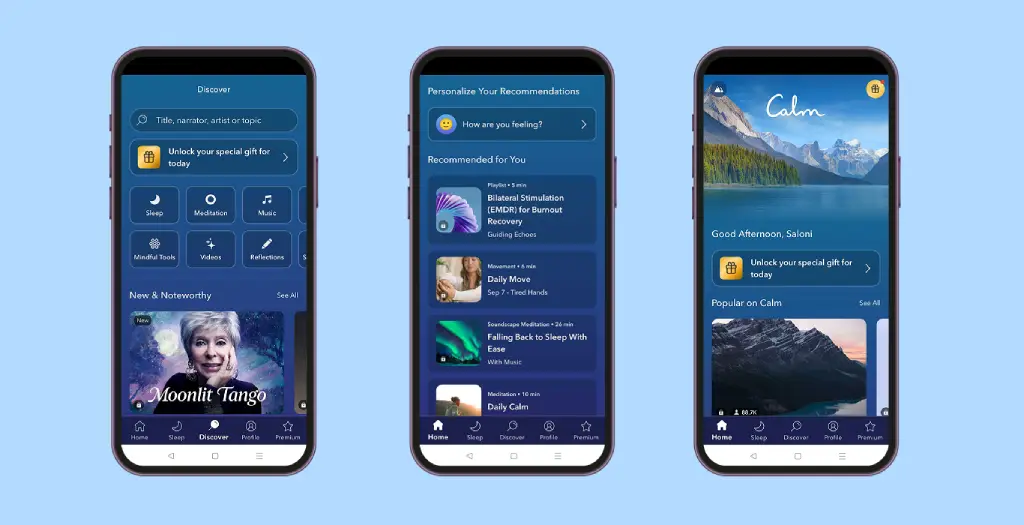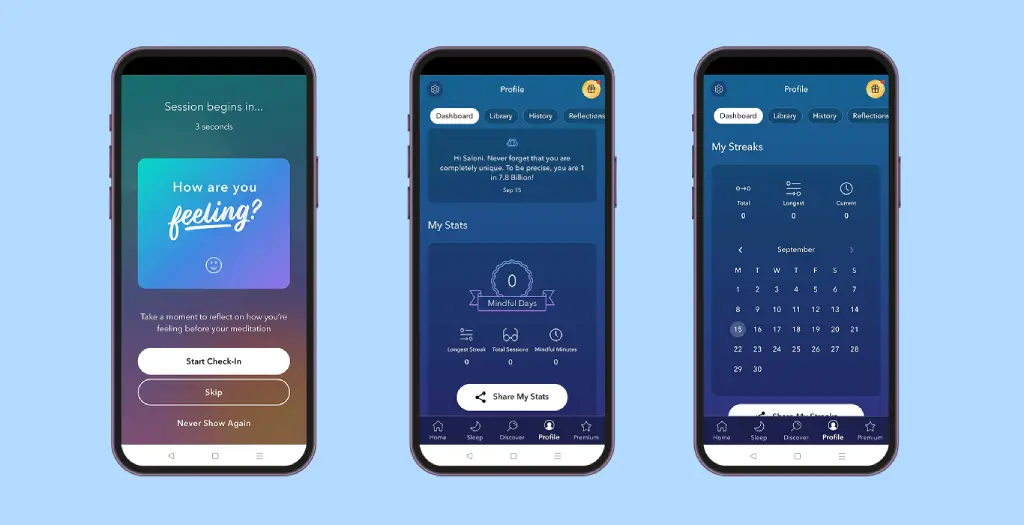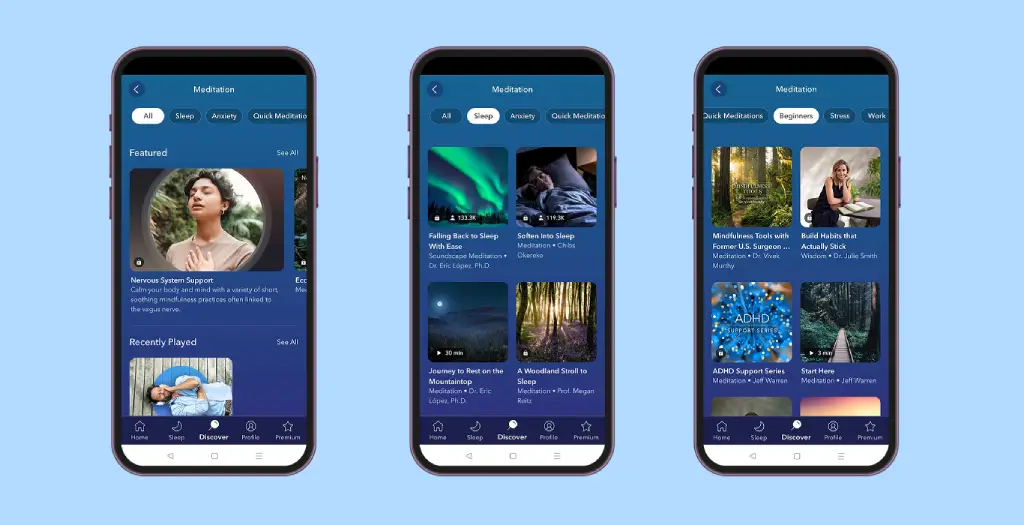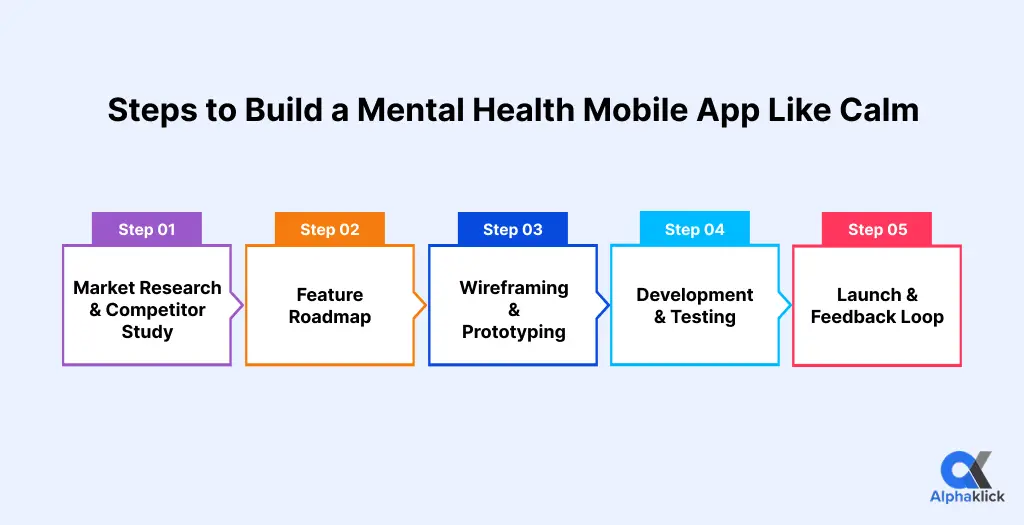Table of Contents
ToggleOver the years, I’ve seen countless mobile apps come and go, but very few have reached the level of Calm.
This platform revolutionized meditation and mindfulness, proving that mental wellness could scale globally through mobile technology.
In fact, according to Statista’s January 2025 report on leading health and meditation mobile apps worldwide, Calm ranked second with nearly 880,000 downloads in just one month, a clear sign of its continued dominance in the wellness space.
Working with many clients to build mental health mobile apps based on their specific requirements, I’ve gained deep insights into what makes these platforms succeed.
In this Calm mobile app development guide, I’m going to walk you through how to build a meditation mobile app like Calm, the must-have features, the right tech stack, and the proven Calm mobile app clone development steps that my team and I have implemented for our clients.
By the end, you’ll have a clear roadmap to turn your wellness mobile app idea into reality.
If you’re exploring advanced use cases, our blog on how to Build an AI-Powered Mental Health Mobile App: Features and Cost shows how AI can reshape this space.
Understanding Mental Health Mobile Apps
A mental health mobile app can serve many different purposes, supporting therapy, tracking moods, offering relaxation tools, or simply helping users unwind after a long day.
Whenever I talk to clients, I emphasize that creating a Calm-like mental health mobile app features list starts with one thing: clarity. Without it, apps often become overloaded and fail to deliver real value.
To make it easier, here’s a breakdown of the main types of mental health mobile apps and what makes each one unique:
| Type of App | Purpose | Popular Examples | Best Use Case |
| Meditation & Mindfulness Apps | Guided meditation, breathing, relaxation exercises | Calm, Headspace, Insight Timer | Stress relief, daily mindfulness practice |
| Therapy & CBT Apps | Connects users with licensed therapists, CBT sessions | BetterHelp, Talkspace | Affordable, remote therapy support |
| Mood Tracking Apps | Tracks mood patterns, emotions, triggers | Daylio, Moodfit | Personal awareness, early signs of mental health issues |
| Wellness Lifestyle Apps | Sleep stories, yoga, fitness, journaling | Aura, Sleep Cycle | Holistic approach to health & wellness |
As you can see, each category offers something different. That’s why the mental wellness mobile app development process must begin with a precise vision of which type you’re building.
Otherwise, you risk creating a mobile app that tries to do everything, but doesn’t excel at anything.
Key Features of a Mental Health App Like Calm
Whenever clients ask me about the key features of Calm mobile app, I explain that success lies in balancing user delight, engagement, and trust.
Below is a structured breakdown that makes a Calm-like mobile app both functional and memorable.
1. Core Wellness Features
- Guided Meditation & Audio Sessions: The foundation of any meditation mobile app, offering structured mindfulness practices.
- Sleep Stories & Relaxation Music: Calm became famous for these; storytelling that eases stress and improves sleep.
- Stress & Anxiety Management Tools: Quick-relief exercises, breathing techniques, and SOS features for users during high-stress moments.

2. Personalization & Insights
- Personalized Content Recommendations: AI-powered suggestions that adapt to each user’s habits and moods, making personalized wellness mobile app development a must.
- AI-Driven Insights: Predictive analytics to track patterns, encourage progress, and provide timely mental health tips.
- Progress Tracking: Celebrating milestones and achievements, often boosted by meditation mobile app gamification strategies like streaks or badges.

3. Engagement & Community
- Community Spaces: Forums, group meditations, or challenges that build a sense of belonging.
- Content Library: A rich and ever-expanding repository of meditations, programs, and exercises, so users never run out of options.

4. Technology & Trust
- Multi-Device Synchronization: Smooth user experiences across mobiles, tablets, and wearables for consistent use.
- Data Privacy & Security: Encrypted storage and HIPAA/GDPR compliance, essential for user trust in healthcare-focused mobile apps.
- AR/VR Meditation Experiences: Advanced AR/VR meditation mobile app features for immersive relaxation and guided journeys.
From my experience, the best approach is to start with a mindfulness mobile app MVP that focuses on the core wellness features and gradually add advanced features like AI-driven insights or immersive interactive meditation mobile app features.
This way, you validate your concept early without overspending, while still leaving room for innovation later.
You can see more examples in our guide on Top health monitoring mobile app features and their development cost in 2025.
Technology Stack for Calm-Like App Development
From experience, I know choosing the right meditation mobile app tech stack in 2025 determines your mobile app’s future performance.
Here’s what my team typically recommends:
| Component | Technologies (2025 Ready) |
| Frontend | React Native (cross-platform), Swift (iOS), Kotlin (Android) |
| Backend | Node.js, Django, Firebase |
| Database | MongoDB, PostgreSQL |
| Cloud Hosting | AWS, Google Cloud |
| AI/ML Personalization | TensorFlow Lite, PyTorch |
| Payment Integration | Stripe, Razorpay |
| Notifications | Firebase Cloud Messaging |
These Calm mobile app backend technologies ensure scalability while keeping the architecture lightweight. I often advise founders not to over-engineer at the MVP stage, invest in the right stack once your growth metrics justify it.
UI/UX Best Practices for Mental Health Mobile Apps
I can’t stress this enough: great mental health mobile app UI/UX design is the secret behind Calm’s global success. People don’t just use Calm for its content; they stay because the mobile app feels like a safe, calming space.
The right design choices directly influence retention, engagement, and emotional impact.
When my team designs a mindfulness mobile app MVP, we focus on three things: simplicity, inclusivity, and personalization.
1. Minimalist Interfaces
Meditation is about focus, so cluttered screens only create distraction. Clean layouts, soft color palettes, and intuitive buttons keep users grounded.
A Calm-like design is not just about looking pretty; it’s about supporting mental clarity.
2. Accessibility by Design
Mental wellness should be for everyone. That’s why our mobile apps always include features like screen readers, text resizing, high-contrast modes, and subtitles for audio sessions.
This ensures people with visual or hearing challenges can still access interactive meditation mobile app features without barriers.
3. Personalized Journeys
Every user’s mental health journey is unique. Through AI, we shape personalized wellness mobile app development flows that recommend specific meditations, sleep sessions, or breathing exercises based on mood, stress levels, and progress history.
This not only improves user satisfaction but also keeps them engaged in the long run.
AI is also playing a big role in this transformation, as explored in How AI is taking over healthcare mobile apps?
4. Emotional Micro-Interactions
Small design elements, like soothing animations, progress confetti, or soft haptic feedback, create a sense of achievement and calmness. These micro-interactions are subtle but powerful in boosting retention.
5. Multi-Device Continuity
Modern users expect consistency. Whether they start a session on their phone and finish it on a smartwatch, or sync across a tablet, multi-device synchronization must be smooth.
This continuity builds trust and keeps people using the mobile app daily.
In my experience, these design details transform a mobile app from functional to unforgettable, turning it into a true digital sanctuary.

Steps to Build a Mental Health Mobile App Like Calm
When I guide clients through the Calm mobile app clone development steps, I always remind them: building a mental wellness platform is more like a marathon than a sprint.
Success doesn’t come from coding alone; it comes from research, validation, and constant iteration.
Here’s how I typically break it down:
1. Market Research & Competitor Study
The journey begins with understanding the ecosystem. Calm may be the leader, but even it doesn’t cover everything.
By studying user reviews, trends, and unmet needs, identify gaps your mobile app can fill. This early stage sets the direction for the entire mental wellness mobile app development process.
2. Feature Roadmap
Next, we define your Calm-like mental health mobile app features. Do you want guided meditations, sleep stories, AI-driven stress management, or AR/VR experiences?
Prioritizing these features ensures your mobile app serves its purpose without overwhelming users.
3. Wireframing & Prototyping
Before writing a single line of code, my team maps out the mobile app visually.
Using Figma, we design wireframes that capture the user journey for a mindfulness mobile app MVP.
This allows you to validate the idea with early testers while saving mobile app development costs.
4. Development & Testing
With clarity in place, we move to mental health mobile app development. My team often uses React Native because it lets us build for iOS and Android with a single codebase, cutting time and cost without sacrificing quality.
It’s ideal for mindfulness mobile app MVPs, offering smooth animations and support for interactive meditation mobile app features.
Paired with the right meditation mobile app tech stack in 2025, we ensure the mental health app is scalable, secure, and polished through rigorous testing before launch.
5. Launch & Feedback Loop
Once live, the real work begins. Early adopters provide insights into what works and what needs refinement.
This is where patience pays off. Iterating with feedback helps refine interactive meditation mobile app features, strengthen retention, and build long-term trust.
I have seen startups rush this Clam mobile app development guide only to crash under poor retention or missed expectations. The mobile apps that succeed, like Calm, are the ones that balance vision with steady, thoughtful execution.
Patience, iteration, and user empathy are the real secret sauce.
Ready to take the next step after building a Calm-style app? See how much it costs to bring it to life in our blog-how much does it cost to build a mental health mobile app like calm.

Challenges in Developing a Mental Health Mobile App
Building a Calm-like mobile app isn’t just about coding; it requires solving deeper challenges that directly impact user trust and long-term success.
From my experience, the most critical ones are:
- Data Security & Compliance: Mental health mobile apps deal with sensitive data. Following HIPAA, GDPR, and regional laws is essential, with encryption and secure cloud hosting at the core.
- User Trust: People won’t engage if they don’t feel safe. Clear privacy policies, credible wellness content, and transparent communication build lasting confidence.
- Market Competition: With new wellness mobile apps emerging every month, differentiation is tough. Success lies in offering unique interactive meditation mobile app features and thoughtful personalized wellness mobile app development strategies.
I have learned that the winners in this space are those who combine healthcare knowledge with solid technology execution; without both, mental wellness mobile apps fail to scale.
How AlphaKlick Can Help You Build a Calm-Like Mobile App
Imagine opening a mobile app that feels less like software and more like a quiet room, designed to lower your pulse the moment you log in.
That’s the approach my team at AlphaKlick takes. As a React Native mobile app development company in India, we focus on building wellness platforms that aren’t just functional, but emotionally resonant, smoothly blending AI-driven personalization, soothing UI/UX, and rock-solid performance.
If you have been thinking about creating a Calm-like experience, this is your chance to stop imagining and start building.
Book a free consultation, and let’s architect something that helps people breathe a little easier every single day.
Frequently Asked Questions (FAQ)
Question: How to build a mobile app for mental health?
Answer: Start with a mindfulness mobile app MVP. Define your niche, design engaging key features of the Calm mobile app, and use the right meditation mobile app tech stack in 2025 for scalability.
Question: How long does it take to create a mental health mobile app?
Answer: On average, following structured Calm mobile app clone development steps, an MVP can be built in 3–5 months. Scaling with advanced AR/VR meditation mobile app features or meditation mobile app gamification strategies takes longer.
Question: How much does it cost to build a Calm-like app?
Answer: The cost to develop a Calm mobile app depends on features and region. An MVP in India may start at $30,000–$50,000, while a full-scale solution with advanced interactive meditation mobile app features in the U.S. can reach $200,000+. For region-specific insights, check our article on How much does it cost to develop a healthcare mobile app in India?

